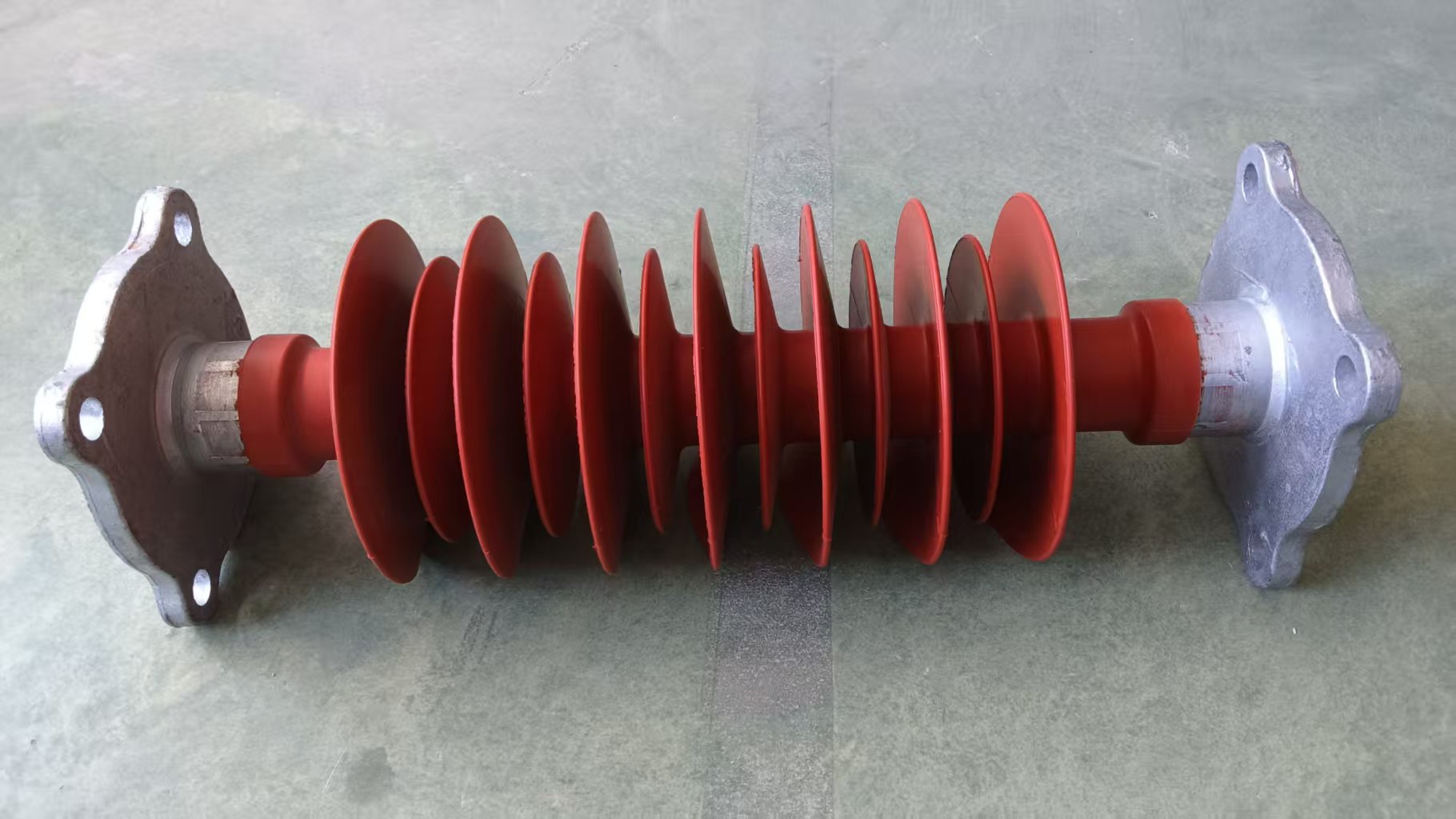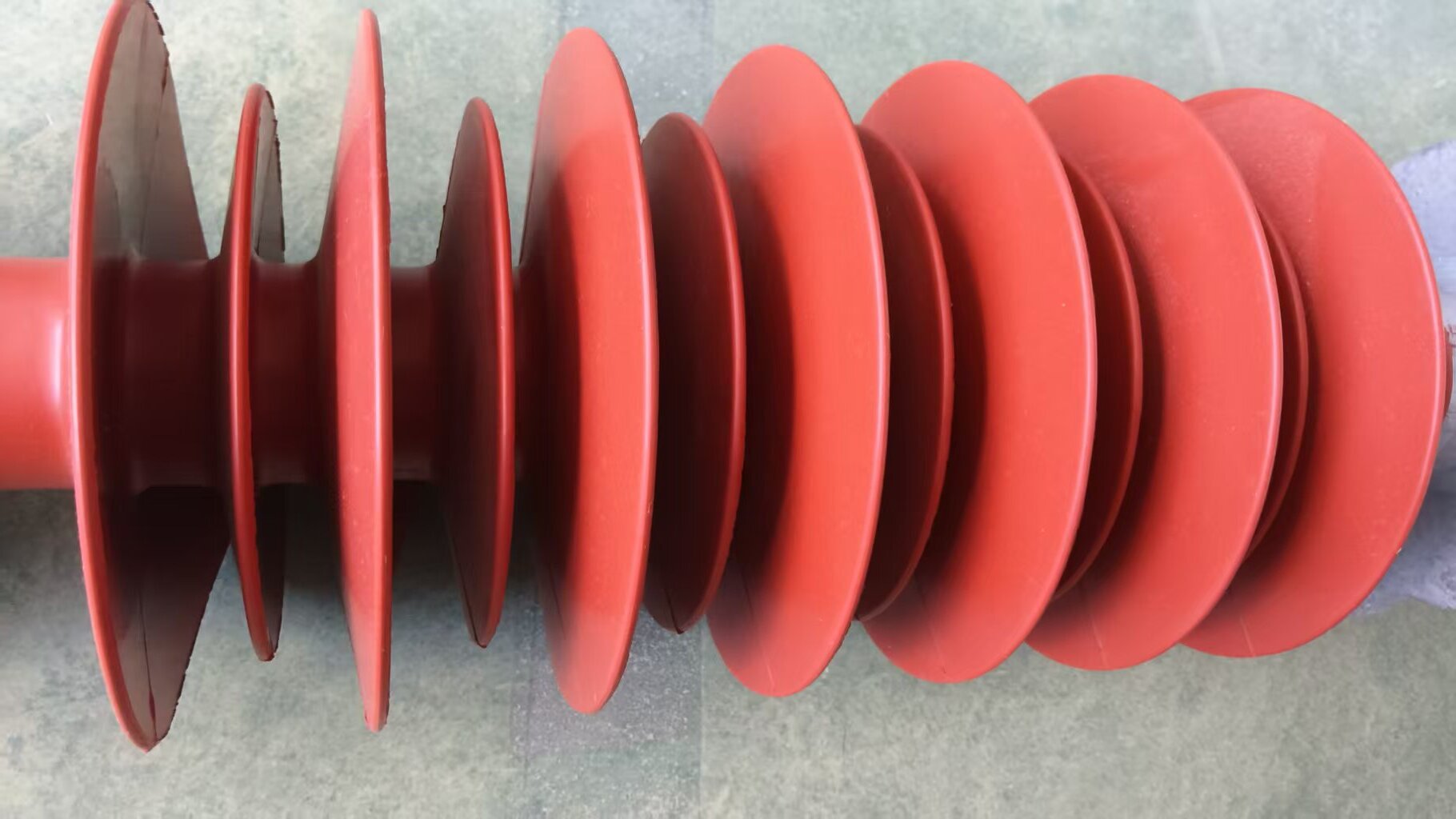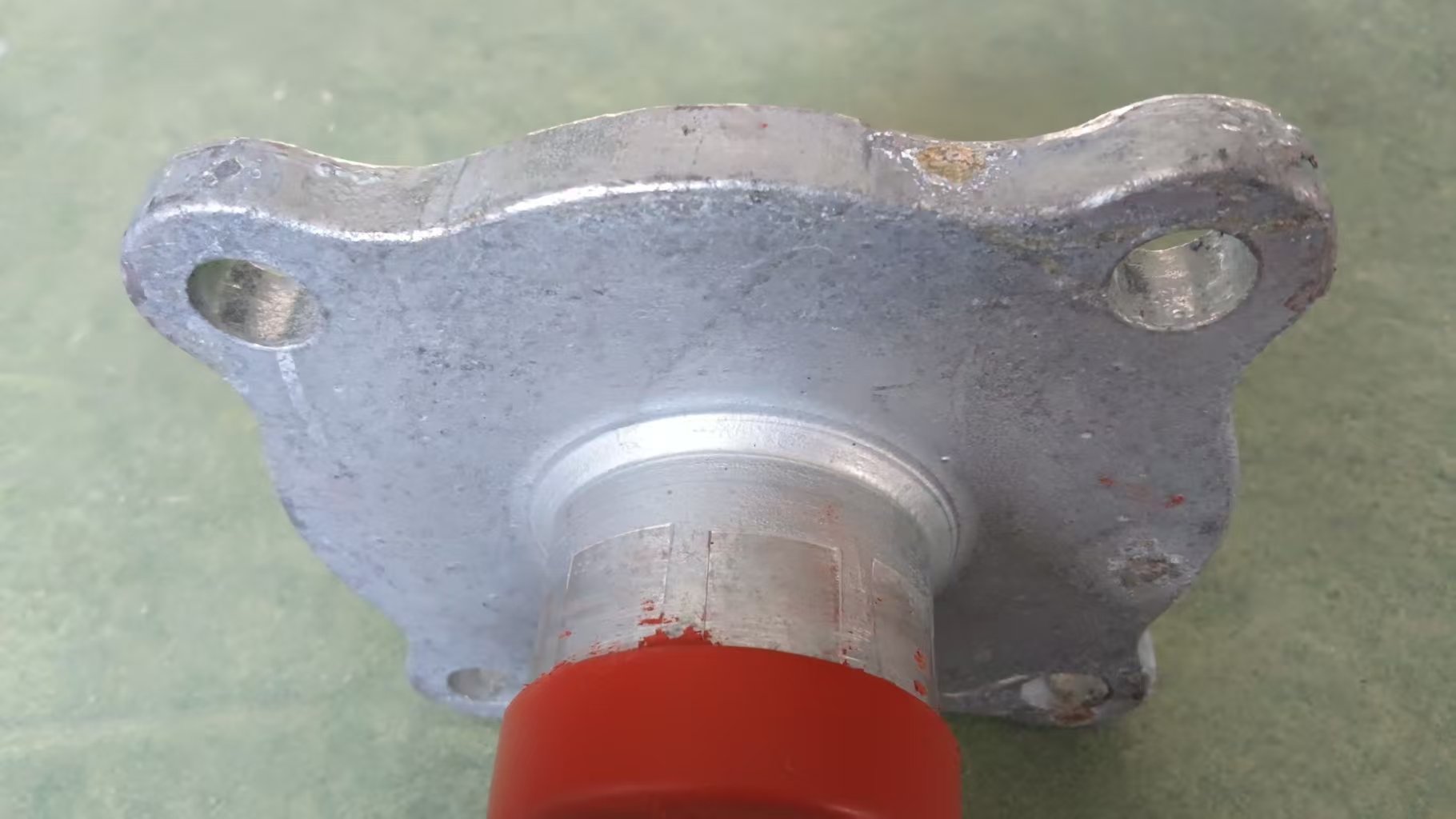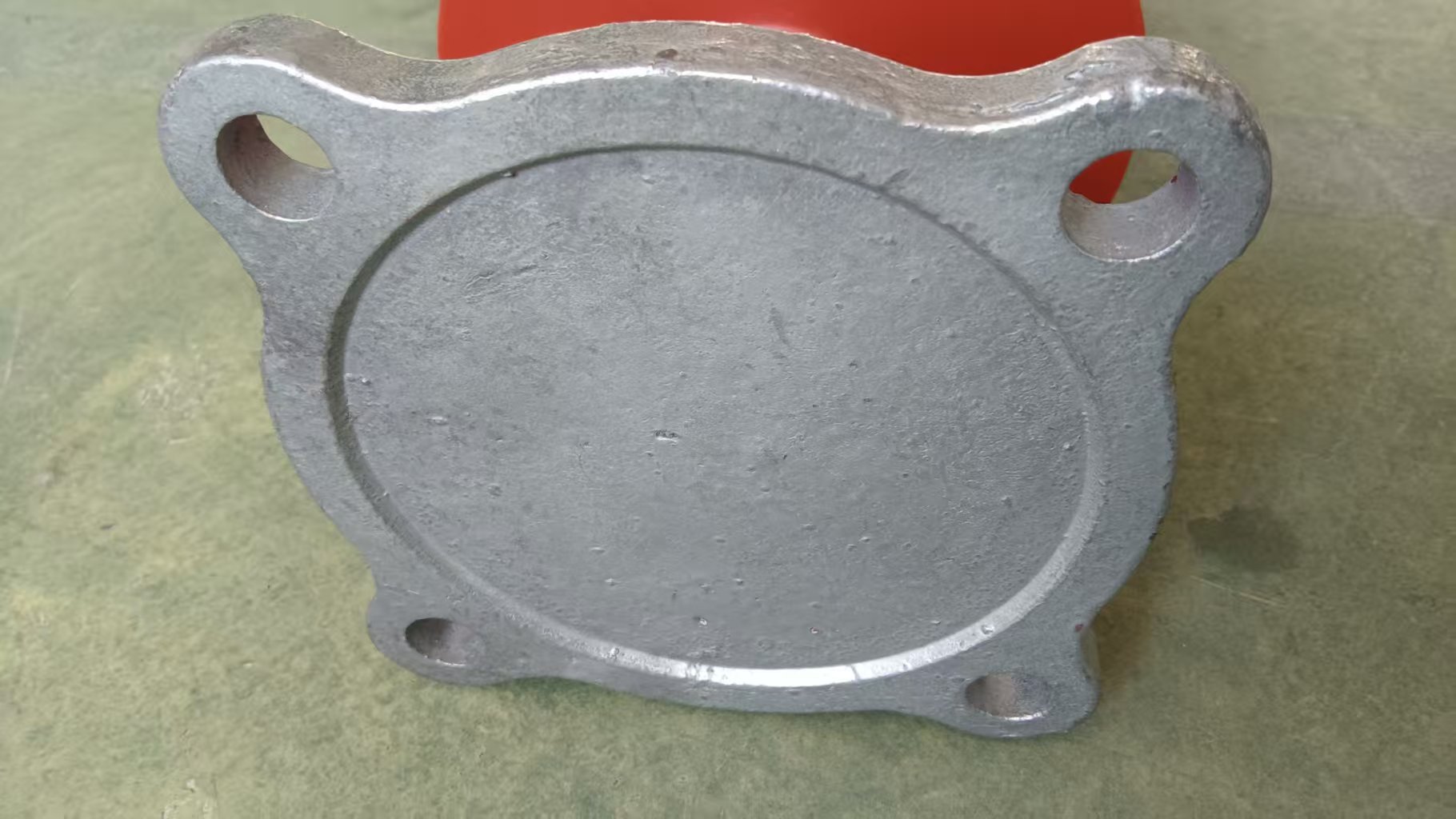| Availability: | |
|---|---|
| Quantity: | |
1. Introduction
This composite station post insulator is prominently identified by its key electrical and mechanical ratings: a system voltage of 35kV and a mechanical cantilever load strength of 8kN. Its most distinctive visual feature is the arrangement of 13 alternating large and small sheds in a striking terracotta red color, which provides a substantial creepage distance of 1260mm. This design is optimized for reliability in challenging environmental conditions.
2.Drawings:

3.Specifications:
Product Type: FZSW-35-8
Height(mm): 435±3
Min Dry Arcing Distance(mm): 290
Min Creepage Distance(mm): 1260
Rated Bending Load(kN): 8
Rated Voltage(kV): 35
Lightning Impulse Withstand Voltage(kV): 185
Power Frequency Withstand Voltage(kV): 80
Mounting hole size: 4xØ14- Ø140
Lower mounting hole size: 4xØ14- Ø140
4. Function
The primary function of this silicone rubber insulator is twofold: electrical insulation and mechanical support.
Electrical Insulation: It physically separates and electrically isolates live high-voltage conductors (e.g., on power lines or substation equipment) from the grounded supporting structure (e.g., a tower cross-arm or pole). It prevents electrical current from leaking (creeping) along its surface to the ground, thereby ensuring the safe and efficient transmission of electricity.
Mechanical Support: It provides robust physical support, capable of withstanding the weight of the conductor, wind loads, ice accumulation, and other mechanical forces, up to its rated 8kN capacity.

5. Features & Characteristics
Composite Material Construction: Unlike traditional porcelain or glass insulators, this high voltage insulator is made from advanced polymer materials. It typically features a core of Fiberglass-Reinforced Polymer (FRP) for exceptional tensile strength and a housing of Silicone Rubber for excellent insulation and environmental protection.
Hydrophobicity: The silicone rubber housing is naturally hydrophobic, meaning it repels water. This prevents water from forming a continuous conductive film on the surface, which is crucial for maintaining insulation performance in rain, fog, or high humidity.
Pollution and UV Resistance: The silicone rubber material is highly resistant to tracking and erosion caused by industrial pollution, salt fog, and other contaminants. It is also formulated to resist degradation from prolonged exposure to ultraviolet (UV) radiation.
Alternating Shed Design (13 Sheds): The key feature of 13 large and small sheds is engineered to maximize the creepage distance. The larger sheds provide greater protected surface area and act as umbrellas for the smaller ones below, while the alternating pattern disrupts the path of contamination and prevents bridging during heavy pollution, enhancing performance in dirty conditions.

High Creepage Distance (1260mm): This long path (the shortest distance along the surface between the metal ends) is a critical metric for insulation in polluted environments. A longer creepage distance makes the insulator far more resistant to flashovers.
Lightweight and Robust: Composite insulators are significantly lighter and more impact-resistant than their porcelain equivalents, making them easier to transport and install, and less prone to damage.
Metal End Fittings: The top cap and bottom flange, typically made of hot-dip galvanized steel or aluminum alloy, provide secure and corrosion-resistant points for connection to the conductor and the support structure.


6. Production Process
The manufacturing of this polymer insulator is a precise and quality-controlled process:
Core Fabrication: The process begins with the production of the load-bearing FRP (Fiberglass-Reinforced Plastic) core rod. Glass fibers are impregnated with epoxy resin and pultruded to form a rod of extremely high mechanical strength.
Molding the Housing: The FRP rod is placed in a heated mold. Sheets of silicone rubber are then compression molded directly onto the core under high temperature and pressure. This process, called injection molding or compression molding, vulcanizes the rubber, bonding it permanently to the core and forming the specific shed profile (the 13 alternating discs).
End Fitting Attachment: The metal end fittings (top cap and bottom flange) are attached to the core. This is most commonly done through a compression (crimping) process, where the fitting is swaged onto the end of the FRP rod, creating a incredibly strong mechanical connection. Alternatively, a cementing process can be used.
Curing and Vulcanization: The entire assembly undergoes a final curing cycle to ensure complete vulcanization and a perfect bond between all components.
Quality Control and Testing: Each batch undergoes rigorous testing, including:
Mechanical Load Test: Proof load tested to verify the 8kN rating.
Electrical Tests: Such as steep impulse front withstand test and power frequency voltage withstand test to verify the 35kV rating.
Dye Penetration Test: To check for any microscopic cracks or faulty interfaces between the rubber, core, and end fittings.
7. Application Scenarios
This type of 35kV composite line post insulator is ideally suited for a wide range of medium-voltage applications, particularly in harsh environments:
Polluted and Coastal Areas: Its long creepage distance and hydrophobic properties make it perfect for use near the sea (salt fog), in industrial zones (chemical pollution), and in desert areas (cement and dust).
Overhead Distribution Lines: Widely used on utility poles and structures for 35kV power distribution networks in cities and rural areas.
Railway Electrification Systems: Used to insulate and support overhead catenary wires that power trains.
Substations and Switchyards: Employed as bus supports, transformer bushings, and in other apparatus within electrical substations.
Mining and Heavy Industry: Its resistance to contamination and robust construction makes it suitable for demanding industrial settings.

Company Strength:
 |  |
 |  |
 |  |  |
1. Introduction
This composite station post insulator is prominently identified by its key electrical and mechanical ratings: a system voltage of 35kV and a mechanical cantilever load strength of 8kN. Its most distinctive visual feature is the arrangement of 13 alternating large and small sheds in a striking terracotta red color, which provides a substantial creepage distance of 1260mm. This design is optimized for reliability in challenging environmental conditions.
2.Drawings:

3.Specifications:
Product Type: FZSW-35-8
Height(mm): 435±3
Min Dry Arcing Distance(mm): 290
Min Creepage Distance(mm): 1260
Rated Bending Load(kN): 8
Rated Voltage(kV): 35
Lightning Impulse Withstand Voltage(kV): 185
Power Frequency Withstand Voltage(kV): 80
Mounting hole size: 4xØ14- Ø140
Lower mounting hole size: 4xØ14- Ø140
4. Function
The primary function of this silicone rubber insulator is twofold: electrical insulation and mechanical support.
Electrical Insulation: It physically separates and electrically isolates live high-voltage conductors (e.g., on power lines or substation equipment) from the grounded supporting structure (e.g., a tower cross-arm or pole). It prevents electrical current from leaking (creeping) along its surface to the ground, thereby ensuring the safe and efficient transmission of electricity.
Mechanical Support: It provides robust physical support, capable of withstanding the weight of the conductor, wind loads, ice accumulation, and other mechanical forces, up to its rated 8kN capacity.

5. Features & Characteristics
Composite Material Construction: Unlike traditional porcelain or glass insulators, this high voltage insulator is made from advanced polymer materials. It typically features a core of Fiberglass-Reinforced Polymer (FRP) for exceptional tensile strength and a housing of Silicone Rubber for excellent insulation and environmental protection.
Hydrophobicity: The silicone rubber housing is naturally hydrophobic, meaning it repels water. This prevents water from forming a continuous conductive film on the surface, which is crucial for maintaining insulation performance in rain, fog, or high humidity.
Pollution and UV Resistance: The silicone rubber material is highly resistant to tracking and erosion caused by industrial pollution, salt fog, and other contaminants. It is also formulated to resist degradation from prolonged exposure to ultraviolet (UV) radiation.
Alternating Shed Design (13 Sheds): The key feature of 13 large and small sheds is engineered to maximize the creepage distance. The larger sheds provide greater protected surface area and act as umbrellas for the smaller ones below, while the alternating pattern disrupts the path of contamination and prevents bridging during heavy pollution, enhancing performance in dirty conditions.

High Creepage Distance (1260mm): This long path (the shortest distance along the surface between the metal ends) is a critical metric for insulation in polluted environments. A longer creepage distance makes the insulator far more resistant to flashovers.
Lightweight and Robust: Composite insulators are significantly lighter and more impact-resistant than their porcelain equivalents, making them easier to transport and install, and less prone to damage.
Metal End Fittings: The top cap and bottom flange, typically made of hot-dip galvanized steel or aluminum alloy, provide secure and corrosion-resistant points for connection to the conductor and the support structure.


6. Production Process
The manufacturing of this polymer insulator is a precise and quality-controlled process:
Core Fabrication: The process begins with the production of the load-bearing FRP (Fiberglass-Reinforced Plastic) core rod. Glass fibers are impregnated with epoxy resin and pultruded to form a rod of extremely high mechanical strength.
Molding the Housing: The FRP rod is placed in a heated mold. Sheets of silicone rubber are then compression molded directly onto the core under high temperature and pressure. This process, called injection molding or compression molding, vulcanizes the rubber, bonding it permanently to the core and forming the specific shed profile (the 13 alternating discs).
End Fitting Attachment: The metal end fittings (top cap and bottom flange) are attached to the core. This is most commonly done through a compression (crimping) process, where the fitting is swaged onto the end of the FRP rod, creating a incredibly strong mechanical connection. Alternatively, a cementing process can be used.
Curing and Vulcanization: The entire assembly undergoes a final curing cycle to ensure complete vulcanization and a perfect bond between all components.
Quality Control and Testing: Each batch undergoes rigorous testing, including:
Mechanical Load Test: Proof load tested to verify the 8kN rating.
Electrical Tests: Such as steep impulse front withstand test and power frequency voltage withstand test to verify the 35kV rating.
Dye Penetration Test: To check for any microscopic cracks or faulty interfaces between the rubber, core, and end fittings.
7. Application Scenarios
This type of 35kV composite line post insulator is ideally suited for a wide range of medium-voltage applications, particularly in harsh environments:
Polluted and Coastal Areas: Its long creepage distance and hydrophobic properties make it perfect for use near the sea (salt fog), in industrial zones (chemical pollution), and in desert areas (cement and dust).
Overhead Distribution Lines: Widely used on utility poles and structures for 35kV power distribution networks in cities and rural areas.
Railway Electrification Systems: Used to insulate and support overhead catenary wires that power trains.
Substations and Switchyards: Employed as bus supports, transformer bushings, and in other apparatus within electrical substations.
Mining and Heavy Industry: Its resistance to contamination and robust construction makes it suitable for demanding industrial settings.

Company Strength:
 |  |
 |  |
 |  |  |
content is empty!